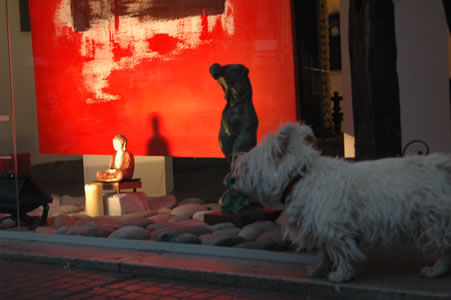San Telmo vies with nearby La Boca for the title of ‘the barrio that birthed the tango.’
While the birthright of tango may be technical, lively San Telmo remains a focal point of the city’s tango and art scenes.
Buenos Aires’ most historic neighborhood has narrow cobblestone streets lined with a mix of resplendent, often crumbling buildings, family-owned bakeries, antique stores, and an eclectic mix of bars, cafes and restaurants.
Fearless kids play soccer on the streets between traffic, cumbia and tango music waft onto the sidewalks, young couples kiss in doorways and cats lounge in windowsills.
If there’s a game on, the screams can be heard every time the national team or the neighborhood’s favorite soccer team, La Boca scores a goal.
‘The Republic of San Telmo’ is chaotic, sometimes dirty and at once touristy in parts, but it is the neighborhood that elicits the deepest and most enduring affection for those visitors who get hooked.
Buenos Aires’ Neighborhood of Immigrants

Named after the Patron Saint of seafarers, San Pedro González Telmo, this area has a long history as Buenos Aires’ most culturally diverse neighborhood.
In the 17th century it was home to laborers arriving from Spain and Italy and later thousands of Irish, Russians, Poles, Germans and freed African slaves.
The 19th-century architecture throughout the neighborhood reveals the brief period when this was one of Buenos Aires’ wealthier districts. Improved infrastructure including sewer lines and gas lights installed in 1852 attracted the well-to-do who built the mansions that can still be seen today.
When a yellow fever epidemic that claimed the lives of thousands broke out here in 1871, wealthy residents moved north to lower-risk areas such as Recoleta.
Left empty, San Telmo’s mansions were divided up and rented to new immigrants who arrived during intense periods of immigration that lasted until after World War II.
Today, the neighborhood is still home to struggling immigrants in low-rent tenements, and even a few remaining squats, but many among the newcomers are European and American travelers as well as students and artisans from all over South America.
Gentrification? Not Like Palermo’
In recent years some residents have griped about what is described as the ‘Palermo-fication’ of San Telmo.
The neighborhood of 26,000 residents has sprucing up in some areas — Latin America’s first five-star gay hotel has come and gone, as well as mom-and-pop ice-cream chains, and boutique clothing shops.
With many locally-owned shops and a bohemian feel, it is the closest thing Buenos Aires has to Barcelona’s Gothic Quarter, especially as the cobblestone quarter becomes more pedestrianized.
A handful of ‘fashion sushi’ spots and ostentatious glass-paneled storefronts look out of place, but overall San Telmo stubbornly remains untamed.
There are a couple of Starbucks and national hamburger chains, but multinational fast-food chains have not yet hit the cobblestone streets at the heart of the neighborhood.
One place where San Telmo’s transformation is striking is the San Telmo Market. Once mostly local grocer, butcher and knick-knack stalls it now has gourmet coffee ,a French bakery and an international array of food offerings, even a popular Pho joint.
Historic Belle-Epoque era buildings have been repurposed into cute hotels and Airbnbs, in the last few years, while many locals remain living here.
Just like 100 years ago, there are newly arrived immigrants living in low-rent ‘conventillos’ or boarding houses.
The neighborhood that claims to be the ‘refuge of friendship and happiness’ refuses to sell its soul.

Experience the passion of Buenos Aires, in the neighborhood that birthed tango.
Check out our curated list of shows that will leave you breathless ➡
Read more about San Telmo:
→ San Telmo Fair Shopping Tips
→ Check out Tango Shows & Tours in San Telmo



2 thoughts on “San Telmo: A Soulful Buenos Aires Barrio that Refuses to Sell Out”
Comments are closed.